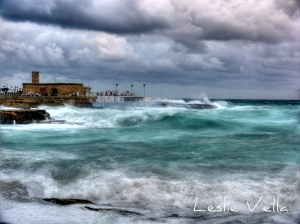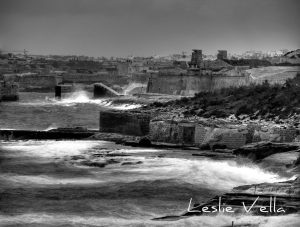When the Greek Wind blows…..
Visualise the Mediterranean: the sea almost completely surrounded by land, the sea lying in between the lands of Europe, Africa and the Middle East. The Middle Sea.
Now place yourself in its centre. A point on two fine, perpendicular cross-hairs, intersecting somewhere south of Sicily, north of Libya. The point? Malta and its Islands. In the middle of the Middle Sea.
To Malta’s north: Sicily, to its south: the massive Libyan coastline. To its west: Linosa, Pantelleria and Tunisia, to its east: the island of Crete. Now continue imagining the points of the compass. To Malta’s north-west: the island of Sardinia and to its south-west: the islands of Lampedusa and Djerba. The south-east also faces Libya while the north-east points directly to the Greek mainland.
The north-east. Source of Malta’s most feared wind, the Grigal. The word Grigal derived from the Maltese word for Greek: Grieg, meaning the Greek Wind. A wind of undisputed ferocity which occasionally hits the archipelago with a force that scares even the most hardened of seafarers. Turning the sea into a no-go area and whipping up a frenzy of churning waters which smash against the exposed coastline.
Thankfully a relatively rare wind which is recorded during only 10% of the days of the year. Generally mild but occasionally wild to the point of being frightening. That’s when it gains the title of Grigallata, the mother of all Greek Winds! The Grigallata blows with strong gale force, reaching Wind Force 9 to 10 at its worst: slightly short of hurricane force. Stirring the sea into a maelstrom, a violently churning liquid mass: beautiful but scary at the same time. Detaching boats from their moorings, uprooting trees, collapsing walls and flooding low lying areas as the incessant waves batter the land with a forceful impact. Creating the sort of stormy seas for which we have the perfect Maltese description: bahar jibla’ l-art which translates into “when the sea wants to swallow the land” such is the power of the waves’ assault on the coast.
The grigal strikes the Maltese coast at its most vulnerable. Given the island’s natural west-east tilt, with high western cliffs and a gently sloping, indented shoreline to the east, this vengeful wind strikes where the harbours, bays and coastal settlements lie. Where the sea is relatively shallow, allowing the waves to accumulate into huge rollers before smashing against the rocky foreshore. The only wind which penetrates into the inner reaches of Valletta’s two marvellous harbours: the reason why the Grand Harbour breakwater was deemed necessary a hundred years ago.
I have to confess a love-hate relationship with the grigal. A love of the unfettered power of this wind in conjunction with the normally placid sea, an appreciation of the untamed force of nature in the face of man’s puny claim to be the master of all around him. But also a hate borne out of its wantonly destructive powers: its capacity to uproot decades-old trees and topple stone buildings as if they were mere haystacks.



I hope you dont mind, but I am printing all your posts to be able to read them in peace and quite and in that way I will be able to enjoy them more. Thank you so so much for sharing them with us, am learning so so much from you and appreciating what we have even more 🙂
Your comment is very much appreciated Rita! Many thanks, Leslie
This sounds frightening, but beautiful too. I think once I would like to experience it.
It was probably the Grigale which traditionally brought St. Paul to Malta also.
Yes, all the way from Crete across some of the deepest waters of the Mediterranean.
Hajr ta din il-kitba tieghek fuq ir-rih tal-Grigal.